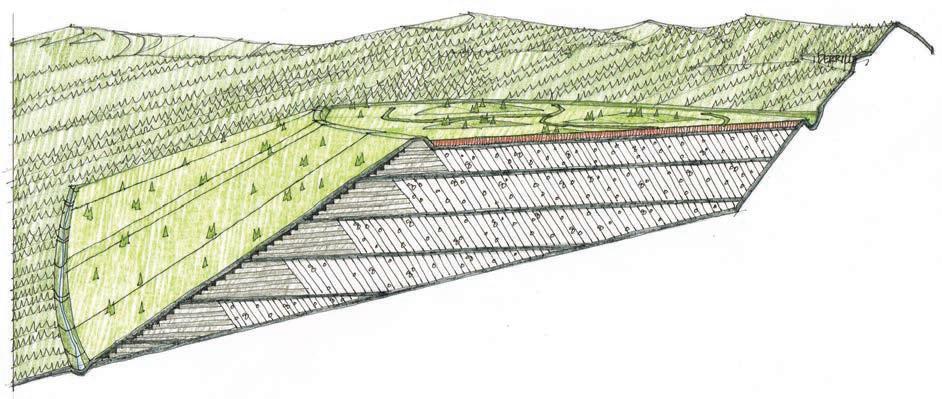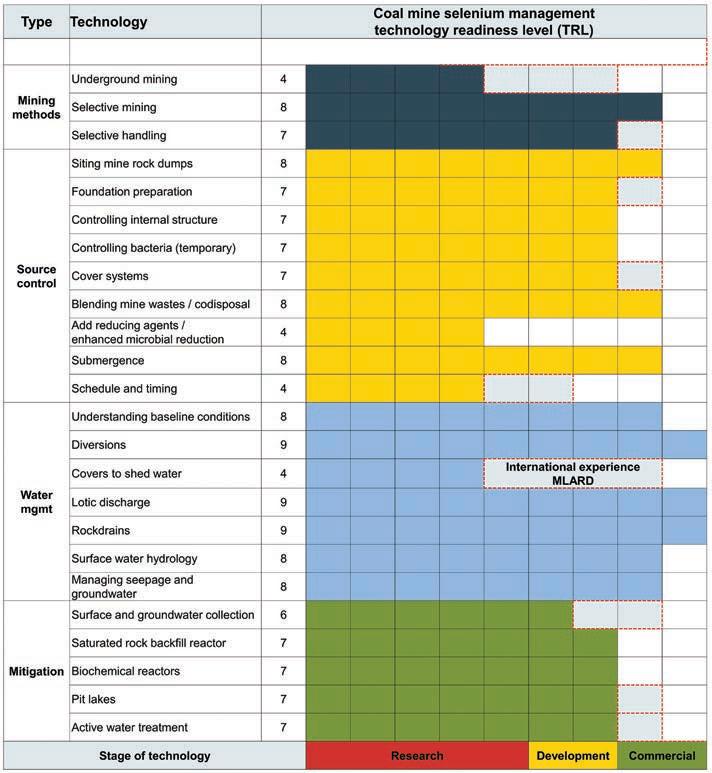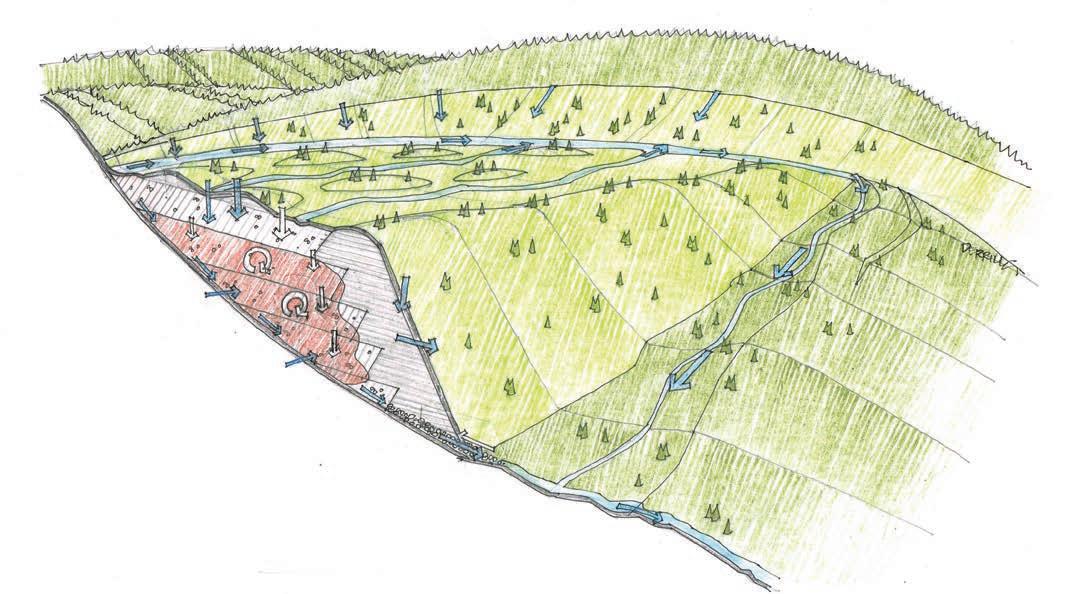
11 minute read
From the bottom up: a proactive approach of landform design and source control.
FROM THE BOTTOM UP
A proactive approach of landform design and source control
Increasingly, two related trends in mine design are becoming apparent. One is mining with the end in mind, or effective landform design (the emerging practice of designing and building truly sustainable mining landscapes from the very outset). The other involves building mine rockpiles that limit the generation and release of potential contaminants within the rockpile (source control) using both old and new technologies, combined with siting and constructing these mining landforms to facilitate the collection and treatment of leachates (leachate control). Together, these trends illustrate a fundamental shift in approach, especially for mines at the permitting stage. At a practical level, it shows the transition from proposing modest measures to control the production and transport of leachate from rockpiles, and then employing adaptive management should conditions worsen, to a proactive approach of limiting water and oxygen fluxes in the design and construction of these landforms that allows for effective capture and treatment of leachates. This strategy better manages the risks by “mining with the end in mind” and adhering to the principles of landform design (see June/July, 2021 issue of CMJ). This article describes how your mine can benefit from these novel approaches.
To illustrate this approach, we provide a simplified example drawn from recent efforts to control selenium leaching from metallurgical coal mine rockpiles under neutral pH conditions (this approach is similar for acid rock drainage elsewhere). At many mines, acid rock drainage and metal leaching (ARD/ML), especially from rockpiles, poses a significant problem, often evidenced by bright orange, ironrich acidic seepage waters. Neutral mine drainage with elevated metals and metalloids can also be an issue. At some coal mines, selenium is present in the mined rock at concentrations of about 2 ppm. When the rock is blasted and stacked loosely in piles, water and oxygen enter-
ing the rockpile cause natural bacteria (the bugs) in the rockpile to oxidize selenium, in turn producing selenate, which is easily leached, reporting to the toe of the rockpile at aqueous concentrations in the range of about 50 ppb and higher. These neutral pH leachate waters flow into local creeks, wetlands, and lakes, potentially leading to bioaccumulation up the food chain, with impacts to fish and bird populations. To manage this situation, many mines employ expensive, long-term seepage and surface water collection facilities, paired with active water treatment plants. Key questions for consideration are how can we “do bet-
“Doing better” means reducing costs, risks and the need for long term treatment.
ter,” especially for new mines? How can we reduce costs and risks? Can we reduce the need for long-term treatment?
To address this issue, landform design can be employed to establish mine rockpiles that restrict contaminant mobility. Initially, a governance team and a multi-disciplinary technical team are established; a design basis memorandum (DBM), which outlines land uses, goals, objectives, and criteria, is clearly set out; and designs are formulated and modelled and subjected to various risk assessments. Pre-planned contingencies are then developed in the case of poor performance, and a monitoring plan is established to identify whether contingencies need to be implemented.
The team subsequently monitors the system to ensure that the rockpile is built to design specifications and is performing as intended. A key part of the DBM is to establish acceptable concentrations and leachate loading to the receiving environment. Generally, no single technology or scheme can be relied upon to control leachate. Instead, the use of multiple technologies in a multiple-lines-of-defence approach is used to provide reasonable assurance that the leachates can be effectively managed. This involves incorporating mining and rock handling methods, source control, water management, and mitigation measures (e.g., collection and treatment) into the system from the beginning.
Ready for prime time?
Mine proponents, regulators, and local communities may be concerned if the proposed technologies are not “proven.” For example, they may still be in the research or development stages. Questions pertaining to technology readiness quickly arise: “Can we rely on a new technology, or do we need to budget for full active water treatment?” Historically, the promise of perfect control and blending of mine wastes and creating anoxic conditions within mine rockpiles, which often resulted in less than stellar results, set source control back several decades. Part of the problem was over-promising and failing to clarify expectations, and part of it was being on the “bleeding edge” of new technologies or testing fallible techniques. Many technologies fail when scaling from the lab scale to the commercial scale.
To meet this challenge, we adapted a scoring system, or technology readiness level (TRL), for use in landform design and associated mitigation measures. It is based on a formulation developed by NASA for space flight technologies. The system provides a simple method to assess technologies and decide on the degree to which they can be relied upon at full commercial scale. The table below illustrates a recent rating using this scoring system to evaluate selenium management in Rocky Mountain coal mines.
The choice of mining technology can have a tremendous impact on ultimate leachate production rates. Underground mining produces much less ARD-ML risk since it produces so much less rock than open pit mining. But underground mining is not an option for most major mines. However, selective mining and handling of mine rock is a common technique, though one that requires much greater quality assurance and quality control
NASA Technology Readiness Level (TRL) system for spaceflight adapted to landform design, employed to classify selenium management technologies for metallurgical coal mines. (QA/QC) by qualified and empowered professionals in the field.
Much research has been conducted on source control for ARD, as well as for selenium leaching. What is becoming a common practice is the multiple-lines-of-defence approach described above. This approach helps control the production of leachates through a combination of effective rockpile design, careful placement, and a robust cover system. The first step is to limit the flux of oxygen into and within the rockpile. This measure maximizes the size of a suboxic zone (in which oxygen concentrations are a few percent versus the 21% in the atmosphere) that will form and limits the volume of water percolating into the rockpile (either from precipitation, run-on from above the rockpile, or as groundwater inputs from the sides of the rockpile).
Source control starts with siting the mine rockpiles. While short hauls and good geotechnical foundation conditions are critical, the landform also needs to be located in an area conducive to the collection of leachates. This usually means avoiding areas in which leachate can percolate into pervious overburden or jointed bedrock with a direct path to the receiving streams. Instead, it requires siting the landform in an area of groundwater discharge in which leachate collection can be conducted reliably. Sometimes a liner under the rockpile will accomplish this objective.
Next, the rockpile is built in layers from the bottom up to control the migration of oxygen within the landform during construction and after reclamation. Traditional end dumping creates long sloping zones of cobbles and coarse boulders that literally allow air to whistle through the landform. Instead, constructing thinner lifts, with compacted low permeability surfaces between lifts, limits gas transport, expanding the size of the suboxic zone. Sometimes, it may be necessary to add or blend mine waste or other materials between lifts to control gas flows, always keeping in mind the need for geotechnical stability (as outlined in the DBM). At the boundaries, engineered covers restrict air and water flux into the rockpile, as do wide zones of compacted, finer-grained materials on the downslope faces. And any rock material that is saturated will not oxidize, and as noted below – and under the right conditions – will reduce and precipitate selenium. Nutrients may be added to the

Water and oxygen fluxes in well-constructed mine rockpiles.

CREDIT: DERRILL SHUTTLEWORTH
rockpile material during placement to enhance bacterial reduction, and hence better immobilize the selenium.
Water management
The next step is to put in place seepage and groundwater control measures. Clean surface water is directed away from the rockpile with diversions (either above or on the rockpile), and a cover system is installed as soon as practical to limit water percolation and oxygen influx into the rockpile. Several diverse types of covers can be employed (e.g., soil covers, membranes) depending on the level of performance required. Lentic waters (those that are slow-moving such as wetlands and lakes) are much more susceptible to selenium bioaccumulation. Therefore, wherever possible, the rockpile is designed to discharge into lotic (fast-moving) waters such as a local stream or river. This is key to protecting downstream aquatic resources, particularly fish populations.
Inevitably, no matter how well a rockpile is designed and constructed, some leachate will be produced, especially during construction before the cover system can be completed. Mitigation of the leachates draining from the rockpile is part of the design and the monitoring and maintenance program and focuses on collection and treatment. If the rockpile is well sited, surface and groundwater collection can be highly effective. Recently, there has been much interest in the use of saturated rock backfills (SRFs) to precipitate selenium. To this end, major pilots, prototypes, and field monitoring are underway that are supported by laboratory studies and a solid theoretical base. Active water treatment is generally considered a commercial technology; even so, these systems need to be adapted to each mine site and performance varies. While semi-passive biochemical reactors (BCRs) are also used commercially, they are typically limited to modest flow rates.

The new strategy
The strategy is tiered and includes these stages: understand the materials and reactions, choose a site for the rockpile that is economical and supports water management for leachate control, construct the rockpile from the bottom up in layers to limit oxygen, blend the waste materials or “add food for the bugs”
CONTINUED ON PAGE 20
Preventable. Prevented.
.com
during placement, and as soon as practical, install a robust cover system. If feasible, the creation of an SRF to promote selenium precipitation is designed into the landform, typically by dumping leachates into a mined-out pit. Mines will often consider using an active treatment system for several years or decades to manage the stored leachates produced before the installation of the cover. Then, when flows, concentrations, and loads are adequately reduced, they switch to a semi-active system for long-term treatment.
The example of selenium management has some unique features; however, with customization, this technique is also applicable to many other methods of mine waste management, including ARD, and for tailings facilities. Although this approach is more effective for new rockpiles, the process of creating a DBM, selecting the technologies, and employing landform design more generally can also be applied to existing active or closed mining landforms, albeit with a reduced set of options available.
In any mine closure and reclamation scenario, there is always inherent residual risk. Failing to understand and accept that risk is a major impediment to every mining stage, from permitting to successful reclamation and aftercare. Getting agreement on residual risk is critical to achieving an acceptable outcome. Some risks come from the adoption of innovative technologies, some from uncertainty in the geological conditions and material properties, some in design and operations, and some in long-term materials and water management.
Ultimately, residual risks will fall to the regulator and local communities, necessitating the establishment of a collaborative approach by the mine proponent with these groups throughout all phases of the mining life cycle, from exploration through to permitting, mine development, the decades of operations and progressive reclamation, closure, and final reclamation, and on into the future. It is not easy. Employing the landform design approach, with clearly defined goals and objectives, thoughtful design, pre-planned contingencies, and an integral monitoring program, within a collaborative stakeholder approach, can be effective at helping mines managing these risks. Then management in turn can provide better assurance for the long-term health of wildlife and wild spaces in the area, generate a better relationship between mines and local communities, and foster a better public reputation for the industry at large. Mining with the end in mind.
Additional guidance
See www.landformdesign.com, the Landform Design Institute’s website, for more how-to guidance on building from the bottom up. CMJ
Gord McKenna is a geotechnical engineer with McKenna Geotechnical in Delta, BC, and the founding chair of the Landform Design Institute. Guy Gilron is a senior environmental scientist with Borealis Environmental in North Vancouver, BC.
www.hrhworkforce.com
RecRuitment of qualified peRsonnel in engineeRing and geosciences
Selection of the candidate Professionnal and background checks Recruitment process Language courses Immigration and arrival processes Integration into the company

... And many more services !
contact one of ouR RepResentatives : Canada : +1 (514) 612-7172 South America : + 57 (601) 790-0072 info@hrhworkforce.com
PLAN NOW TO REACH CANADA’S MOST INFLUENTIAL MINING AUDIENCE
Canadian Mining Journal’s 2022 Editorial Calendar and media kit is now available via this link: https://mediakit.northernminer.com/canadianmining-journal/ You can also contact the Publisher, Robert Seagraves, at rseagraves@canadianminingjournal.com or 1-416-510-6891 for more marketing information.








